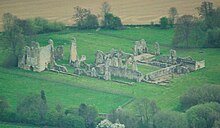
An abbey is a type of monastery used by members of a religious order under the governance of an abbot or abbess. Abbeys provide a complex of buildings and land for religious activities, work, and housing of Christian monks and nuns.

Norbert of Xanten, O. Praem (Gennep-Magdeburg), also known as Norbert Gennep, was Archbishop of Magdeburg, founder of the Premonstratensian order of canons regular, and is venerated as a saint in the Catholic Church. Norbert was canonized by Pope Gregory XIII in the year 1582, and his statue appears above the Piazza colonnade of St. Peter's Square in Rome.

The Order of Canons Regular of Prémontré, also known as the Premonstratensians, the Norbertines and, in Britain and Ireland, as the White Canons, is a religious order of canons regular of the Catholic Church founded in Prémontré near Laon in 1120 by Norbert of Xanten, who later became Archbishop of Magdeburg. Premonstratensians are designated by OPraem following their name.

Lamberhurst ( is a village and civil parish in the borough of Tunbridge Wells in Kent, England. The parish contains the hamlets of The Down and Hook Green. At the 2001 Census it had a population of 1,491, increasing to 1,706 at the 2011 Census.

Titchfield Abbey is a medieval abbey and later country house, located in the village of Titchfield near Fareham in Hampshire, England. The abbey was founded in 1222 for Premonstratensian canons, an austere order of priests. The abbey was a minor house of its order, and became neither wealthy nor influential during its three centuries of monastic life; the inhabitants were devoted to scholarship, as shown by their very impressive library.

Leiston Abbey outside the town of Leiston, Suffolk, England, was a religious house of Canons Regular following the Premonstratensian rule, dedicated to St Mary. Founded in c. 1183 by Ranulf de Glanville, Chief Justiciar to King Henry II (1180-1189), it was originally built on a marshland isle near the sea, and was called "St Mary de Insula". Around 1363 the abbey suffered so much from flooding that a new site was chosen and it was rebuilt further inland for its patron, Robert de Ufford, 1st Earl of Suffolk (1298-1369). However, there was a great fire in c. 1379 and further rebuilding was necessary.
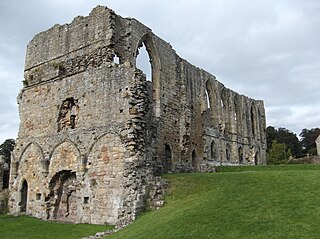
Easby Abbey, or the Abbey of St Agatha, is a ruined Premonstratensian abbey on the eastern bank of the River Swale on the outskirts of Richmond in the Richmondshire district of North Yorkshire, England. The site is privately owned but maintained by English Heritage and can be reached by a riverside walk from Richmond Castle. Within the precinct is the still-active parish church, displaying 13th-century wall paintings.
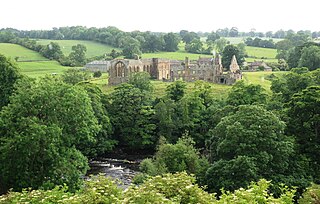
Egglestone Abbey is a ruined Premonstratensian abbey in County Durham, England. It is located 1+1⁄2 miles (2.4 km) south-east of Barnard Castle, on the south bank of the River Tees, and was historically within the North Riding of Yorkshire.
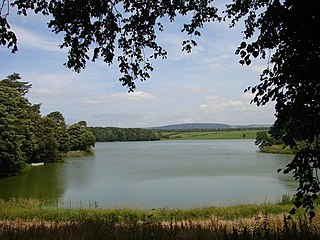
Saulseat or Soulseat Abbey was a Premonstratensian monastic community located in Wigtownshire, Galloway, in the Gaelic-speaking south-west of Scotland.
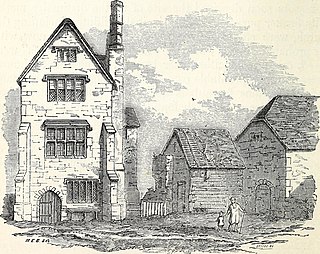
Dureford Abbey, in Sussex, England, was a Premonstratensian monastery. It was founded by Henry Hussey, who in 1161 granted land to the abbot of Welbeck Abbey, to establish the new community near Rogate, Sussex.

Michelham Priory is the site of a former Augustinian Priory in Upper Dicker, East Sussex, England, United Kingdom. The surviving buildings are owned and administered by the Sussex Archaeological Society and are Grade I and Grade II listed.

Tupholme Abbey was a Premonstratensian abbey close to the River Witham some 10.5 miles (16.9 km) east of the city of Lincoln, England and one of nine such abbeys within the historical county. The Witham valley in Lincolnshire is notable for its high concentration of monasteries—there were six on the east bank and three on the west—all presumably drawn to the area by the usefulness of the River Witham for transport and by the wealth that it transported. The abbey was largely destroyed by 1538, after being seized during Henry VIII's Dissolution of the Monasteries.

Our Lady of England Priory in Storrington, West Sussex, England is the former home of Roman Catholic priests belonging to a Community of Canons Regular of Prémontré, after the place where they were founded in France in 1121. The priests are also known as Norbertines after Norbert of Xanten, the Founder of the order. Because of their white habits, another name for members of the Order is White Canons. The priests follow the Rule of St Augustine.
Otham Abbey was a medieval monastic house in Polegate, East Sussex, England.
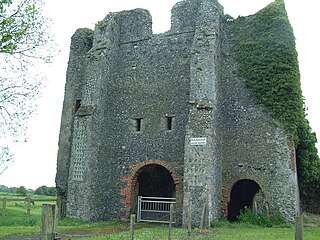
St. Radegund's Abbey at Bradsole was a medieval monastic house in the parish of Hougham Without near Dover in southeast England. It was dedicated to Radegund, the sixth-century Merovingian princess, who, once married to the unsavory King Chlothar I, turned to a life of asceticism and charitable works. The remains of the abbey buildings have since have been incorporated into a farm.

Newsham Abbey was an abbey in Newsham, a small hamlet north of Brocklesby village in Lincolnshire, England, and one of nine within the historical county. Founded by Peter of Gousla in 1143, Newsham was a daughter house of the Abbey of Licques, near Calais, and the first Premonstratensian house established in England.
Sulby Abbey was a Premonstratensian house in Northamptonshire, England, founded in 1155 as daughter house of the Abbey of St. Mary and St. Martial in Newsham.

Buckhurst Park is an English country house and landscaped park in Withyham, East Sussex. It is the seat of William Sackville, 11th Earl De La Warr.
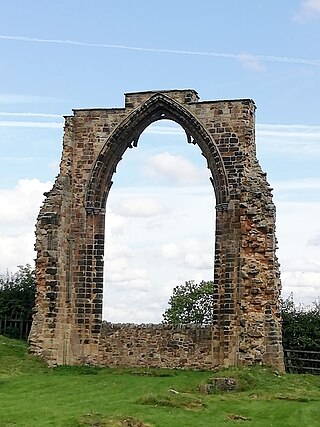
Dale Abbey, also known as the Abbey of Stanley Park, was a religious house, close to Ilkeston in Derbyshire. Its ruins are located at the village of Dale Abbey, which is named after it. Its foundation legend portrays it as developing from a hermitage, probably in the early 12th century.

